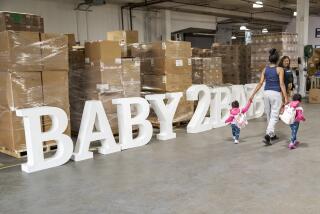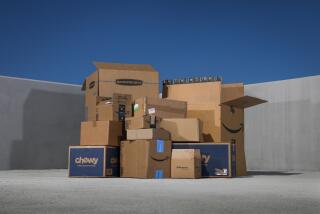INVENTORS : Times Are Changing : Environment: Rachael Flug created the Diaperap to keep cloth diapers from leaking. But her biggest challenge is fighting the disposable industry.
- Share via
Rachael Flug is at the front lines of the eco-war to promote reusable products, and her critical battleground is a place where, really, only peace and motherly love should reign: right in the nursery.
Crucial to Flug’s victory are the choices a new mother makes when she brings her baby home from the hospital. Should she use disposable diapers, or cloth? If she opts for cloth, should she go the age-old, plastic-pants-and-pins route, or use fabric covers?
For Flug is not only an ardent environmentalist and advocate of reducing landfill waste, but also a businesswoman with the continued well-being of her company at stake. The Northridge mother of three is the inventor of the Diaperap, a washable cloth diaper cover with a foam backing that is designed to prevent leakage and eliminate rashes.
As is often the case, necessity was the mother of Flug’s invention. In the early 1980s, when her family lived in the heat and humidity of Hong Kong, her infant son developed a diaper rash so fierce that nothing seemed to alleviate it. Finally, to give her baby some relief, Flug abandoned plastic pants and whipped up her first fabric cover.
Soon, mothers she knew were asking her for some, too. The rest, as they say, is history.
Since 1985, Flug’s company has blossomed from a two-person enterprise operating out of a small garage--and then a larger one--to an expanding shop with 22 employees and a respectable address next to a business park. Diaperaps Ltd. is now the largest manufacturer and distributor of diaper covers nationwide.
But although Flug sells more than 1 million Diaperaps a year and was a finalist for Inc. magazine’s local 1991 “Entrepreneur of the Year” award, she is facing perhaps her biggest challenge these days--overcoming consumers’ newfound confusion over whether cotton diapers really are better for the environment than disposables.
“There is a perception, a perception which is backed by hundreds of millions of dollars in advertising, that the disposable diaper is the ultra-modern, high-tech, most convenient way to go,” Flug, 37, said in a recent interview. “And if you muddle the picture enough for people, then people feel they can’t make a difference.”
What Flug calls “muddling” is merely the latest, well-aimed salvo fired by the Goliath of the diaper industry, Procter & Gamble, makers of Pampers and Luvs and the holder of the largest share of the disposable pie.
In a savvy and well-timed advertising campaign, Procter & Gamble managed to stem a rising tide of cotton diaper-buying that peaked in the wake of Earth Day 1990. Mostly in magazine ads, the corporation introduced the idea of Luvs and Pampers as biodegradable, thereby soothing the worries of consumers who were growing squeamish about mountains of trash accumulating in the nation’s landfills.
Attorneys general in 10 states, including California, investigated the “green marketing” claims and found that some were misleading. For one thing, it turned out that only 80% of the product was compostable. Procter & Gamble agreed to modify its advertising.
Responding to Flug’s criticisms, Procter & Gamble defends its ads. “The facts that we had in the ads were absolutely on target. We just had to add some,” said Lynn Hailey, a corporate spokeswoman in Cincinnati.
As to which is easier on the environment, Hailey said: “It’s not a black or white issue. If you zero in on the solid-waste issue, then disposables do have an impact. But when you look at the broad perspective, you have to talk also about water consumption and air pollution being the result of laundering and delivery of cotton diapers.”
For her part, Flug presses forward with firebrand enthusiasm and a reputation for perfectionism in her quest to win consumer confidence and a bigger portion of infant-product market.
Studies show that 85% of parents use throw-away diapers, and Flug has revised her original cover three times in an attempt to lure more customers. Her latest version is a 100% cotton knit Diaperap that is snazzier in design, lighter, thinner, more resistant to shrinkage and leakage, and has four Velcro tabs instead of two.
She has also expanded her product line, developing contour diapers and liners, both items spun of Egyptian cotton, which Flug said is highly absorbent because it fluffs up to three times its thickness after washing.
Flug has sharpened her product through feedback from mothers who visit the office to try Diaperap’s products on a changing table, and from experimenting on her own children.
“It helps a lot because I had babies to try it out on,” she said. “The day Joanna was born--don’t you believe it?--I was testing new covers on her.” (Her daughter Joanna is now 4.)
Gloria Zeltzer of Granada Hills was one of several mothers invited by Diaperaps to come in and try out test models. She went with cloth for her second child, 2-year-old Hannah, after her awareness of ecological issues grew.
“I think they’re great,” she said. “The earlier ones were a little bulky and they tended to get wet all the way through, but I never had a rash problem.” Zeltzer said she likes the new version because the fabric is thinner and the fit is “really slim.”
The middle model is utilitarian enough for Collette Beagin of Sylmar, mother of 10-month-old Shannon. Beagin ordered the product “because my husband’s not really good at handling pins.” If she had occasion to offer constructive criticism, it would be that “the Velcro sometimes wears out pretty quick . . . but, then again, my daughter’s pretty large.”
Of the design intricacies, Flug said: “It may look simple, but I can tell you it is a very technical, complicated product. It’s very subtle--what elastic you use, how you bind it, how tight you make it--all of this affects how the product is going to work for the baby.”
Wayne Rockwell, manager of the Rhode Island textile plant where Diaperaps are made, describes Flug as very exacting. “I’ve known her for years, and she’s very strict. We have to be very careful in our inspections, or, believe me, we hear about it.”
In 1985, when things really got rolling for Flug and her husband, Abraham Entin, 47, she marketed a diaper cover that today might not cut it in a competitive field of about half a dozen such manufacturers.
Later, to hold onto the new, ecology-minded customer for whom convenience was also a draw, Flug not only had to improve the product, but make inroads institutionally as well.
Many hospitals, which by law are now required to reduce their waste, are using specially designed Diaperaps with cutaways at the top so umbilical cords can heal, and childbirth instructors are demonstrating cloth-diapering techniques to expectant mothers.
One author, Janis Graham of “Your Pregnancy Companion,” published by Pocket Books in 1991, recommended Diaperaps as the “most inexpensive covers and the easiest to use and care for,” printing the business’s toll-free order line.
To new mothers, all this can be as good for diaper covers as Michael Jordan endorsements are for high-tops.
With Flug as president, focusing on product development and the finances, and Entin as executive vice president, the company now sells its line in more than 1,500 stores, through 1,000 diaper services and hospitals, through the J.C. Penney catalogue, and also through direct orders.
In her start-up year, Flug sold 25,000 covers at $10 apiece. Seven years later, the more than 1 million covers she sells annually now are priced closer to $8 apiece.
Those figures and the timeliness of Flug’s anti-waste crusade drew the attention last year of scouts at Ernst & Young, a co-sponsor with Inc. magazine of the “Entrepreneur of the Year” contest.
“She took the problem of paper diapers and turned it into a way to make cotton diapers useful,” said Ron Silver, an Ernst & Young partner. “That was something that was very ecologically minded.”
Silver chose Flug as one of three Los Angeles region finalists in the manufacturing category, but the winner was a man who developed collapsible housing and shelters used by the military in the Persian Gulf War. “She’ll win one of these years,” he said.
In the meantime, Flug is warily keeping an eye on the moderate slowdown that followed Procter & Gamble’s ad blitz. Last year, she had to lay off about eight employees, something she said she hated doing, but learned from: She must be careful not to overexpand.
Flug seems confident about the future of Diaperaps. Her biggest supporter is Entin, her husband of 16 years, who serves as the enterprise’s marketing and sales force.
“Rachael is one of the most competent people I have ever met,” Entin said, noting that he and his wife work side by side with ease. “I always had the faith that the company would be successful, because I always had the faith in Rachael.”
There is little in Flug’s background that could have prepared her for a career as an inventor and entrepreneur, except maybe her leadership qualities, which emerged early, and a willingness to follow the road less-traveled.
Raised in Long Island, N.Y., she moved to Southern California after high school, where she was student body president, an intern to a judge, and a volunteer in the effort to get the voting age lowered to 18.
At UCLA, Flug studied history of science and intended to pursue a law degree until she was arrested for hitchhiking and her case was heard by a male judge whom she felt treated her unjustly because she was a young woman.
She left college and headed for Oregon, where she and Entin explored the world of health food and writing for an alternative newspaper. Around this time, Flug had “a very powerful dream” and started writing a novel, “an adult fairy tale” that has to do with good versus evil. “It deals a lot with illusions and the fact that people don’t always realize the consequences of them,” she said.
She has about 400 pages written, but clearly is being pulled away from this book by more pressing demands. Besides running Diaperaps, Flug is an active mother to her children--Joanna, Jubilee, 15, and Jona, 11. All three were born at home with the assistance of midwives. She serves on the board at her children’s school, is president locally of a nonprofit, philosophical foundation called the Anthroposophical Society, and, in her spare time, enjoys scripting elaborately staged back-yard puppet shows.
Flug also makes it a point to “give something back” by donating Diaperaps to such diverse groups as Haitian refugee families, Romanian orphans and organizations caring for babies with AIDS.
Flug credits her mothering instincts for paving the way to success in business.
“Really being a good mother means letting go as your child grows up. It’s a continual process, and, in a way, it’s useful in the company. While other people were saying, ‘Oh, you have a good product, why change it?’ I knew we had to let go, and develop something even better.”
And then there’s the message of social responsibility she hopes to send to her children through her role as president of Diaperaps:
“One thing I think parents sometimes overlook is the impact they can have on children under 3. Do they learn from their parents that you just take human waste and wrap it up and throw it out? It isn’t magic, and it just doesn’t disappear.”
More to Read
Inside the business of entertainment
The Wide Shot brings you news, analysis and insights on everything from streaming wars to production — and what it all means for the future.
You may occasionally receive promotional content from the Los Angeles Times.










